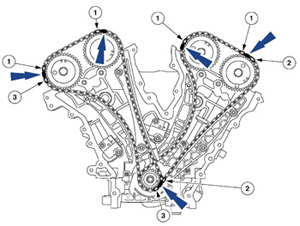If you have to remove or replace a cylinder head for any reason, or replace the timing chain on a 3.0L Duratec, it can be a bit of a challenge because Ford doesn’t provide a Top Dead Center (TDC) timing reference mark on the crankshaft.

You will have to use a dial indicator to find the TDC position of the number one cylinder on Ford’s 3.0L Duratec to make sure the crank and camshafts are all properly aligned.
Ford says that when the crankshaft keyway is positioned at roughly the 11 o’clock position, the number one cylinder should be at TDC.
Before you can remove the timing chain, the front cover has to come off the engine. Then you have to remove the crank sensor pulse wheel. Note the sensor wheel’s location before you remove it.
Rotating the crank until the keyway is at the 3 o’clock position will move the right cylinder head camshafts to the neutral position. The timing mark on the intake cam should be pointing to the right when viewed from the front, and the timing mark on the exhaust cam should be pointing straight up if both cams are in the correct position.
You can now remove the chain tensioner arm, chain guide and right timing chain.
To remove the left timing chain, rotate the crank clockwise 600° (1-2/3rds turn) until the keyway is again at the 11 o’clock position. This will position the left cylinder head cams in the neutral position. This time, the timing mark on the intake cam should be pointing to the left when viewed from the front, and the mark on the exhaust cam should be pointing straight up. As before, you can now remove the chain tensioner arm, chain guide and left timing chain.
Before you can reinstall the timing chains, you need to compress the left and right chain tensioners in a vice. Compress the piston until it is fully bottomed, then temporarily lock it in place with a pin or paper clip.
If the replacement timing chain does not have timing marks for aligning with the cam gears, you’ll have to mark the left and right side chains. Start with the left chain, and mark one link as the starting crankshaft timing mark. Then count 29 links and make a second mark (for the exhaust cam). Continue counting to link number 42 and make a third mark (for the intake cam). The second and third marks should align with the timing marks on the intake and exhaust cams when the chain is slipped into place. The chain tensioner and arm can now be installed.
Next, you do the same procedure for the right cam. But first, you need to rotate the crankshaft 120° clockwise so the crankshaft keyway is at the 3 o’clock position. Mark the right timing chain and install it the same as before. Once both chains are in place, remove the locking pin or paper clip from the left and right chain tensioners.
Rotate the crankshaft 120° counterclockwise so the keyway is back at the 11 o’clock position and number one piston is at TDC. Check to make sure all the timing marks are aligned as shown in the illustration.
There should be 12 chain links between the right and left intake and exhaust cam sprocket marks, 27 chain links between the cam gears and crank on the non-tensioned side of each chain, and 30 links between the cam gears and crank on the tensioned side of each chain.
